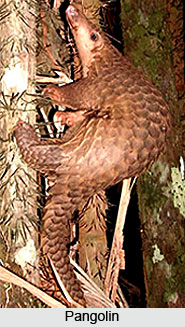
The Indian pangolin, scientifically known as Manis
crassicaudata, is a unique mammal known for its distinctive physical
characteristics. It is covered in large, overlapping scales made of keratin,
the same material as human nails and hair. These scales serve as a protective
armor against predators. An adult Indian pangolin typically measures between 45
to 75 centimeters in length, excluding the tail, which can add an additional 33
to 45 centimeters. The weight of this species ranges from 10 to 16 kilograms.
Their color varies from yellow-brown to dark brown, and they possess small,
conical heads with no teeth. Instead, they have long, sticky tongues, which can
extend up to 40 centimeters, designed to capture ants and termites, their
primary diet.
Habitat
Indian
pangolins are primarily nocturnal and solitary creatures, known for their
secretive nature. They inhabit a variety of environments, including tropical
forests, grasslands, and dry, arid regions. These mammals are adept burrowers,
often constructing intricate underground tunnels that can reach depths of up to
5 meters. These burrows provide shelter and protection from extreme weather and
predators. Their habitat preference includes areas with abundant ant and
termite populations, as these insects constitute their main food source. The
pangolins use their powerful forelimbs and sharp claws to dig into termite
mounds and ant nests.
Concentration in India
The Indian pangolin is widely distributed across the Indian subcontinent. In India, their presence is noted in various states including Andhra Pradesh, Chhattisgarh, Jharkhand, Karnataka, Kerala, Madhya Pradesh, Odisha, Tamil Nadu, and West Bengal. Additionally, they are found in the Himalayan foothills and the northeastern parts of the country. Despite their broad distribution, the population density of Indian pangolins is relatively low, and they are considered a rare species in many areas.
The species faces significant threats from poaching and
habitat destruction. Pangolins are heavily poached for their scales, which are
highly valued in traditional medicine and for making ornaments. Their meat is
also considered a delicacy in some cultures. These pressures have led to a
severe decline in their population. As a result, the Indian pangolin is listed
as Endangered on the International Union for Conservation of Nature (IUCN) Red
List.
Conservation Efforts
To combat the decline in the Indian pangolin population, several conservation measures have been implemented. These include legal protection under national and international laws. In India, the species is protected under the Wildlife Protection Act of 1972, which prohibits hunting and trade of pangolins. Additionally, various wildlife organizations and NGOs are working towards the conservation of this species through habitat preservation, anti-poaching efforts, and awareness campaigns.
Conservationists emphasize the importance of habitat conservation and restoration to ensure a stable environment for the Indian pangolin. Education and community involvement are also critical, as they help reduce human-pangolin conflicts and raise awareness about the species' plight.
The Indian pangolin, with its unique physical features and
specialized diet, plays a crucial role in the ecosystem by controlling insect
populations. It is an integral part of Indian flora
and fauna Despite its wide distribution in India, it faces significant
threats that have led to its endangered status. Conservation efforts, including
legal protection and community engagement, are essential for ensuring the
survival of this remarkable species. Protecting the Indian pangolin requires
continued dedication and collaborative efforts to address the challenges posed
by poaching and habitat destruction.